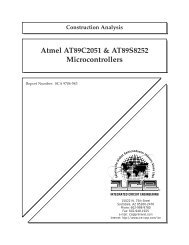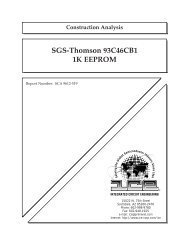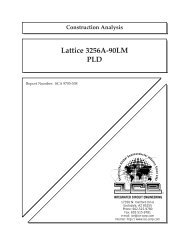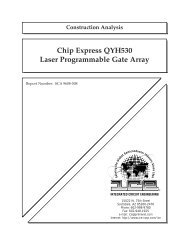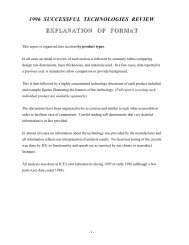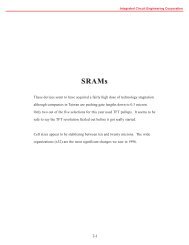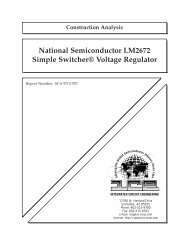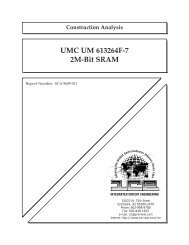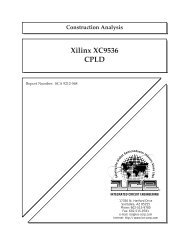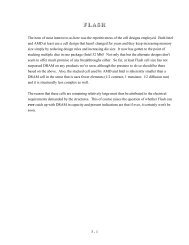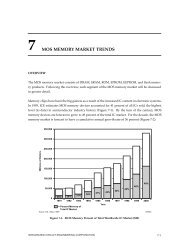Motorola PC603R Microprocessor - Smithsonian - The Chip Collection
Motorola PC603R Microprocessor - Smithsonian - The Chip Collection
Motorola PC603R Microprocessor - Smithsonian - The Chip Collection
You also want an ePaper? Increase the reach of your titles
YUMPU automatically turns print PDFs into web optimized ePapers that Google loves.
Report Number: SCA 9709-551<br />
Construction Analysis<br />
<strong>Motorola</strong> <strong>PC603R</strong><br />
<strong>Microprocessor</strong><br />
Serving the Global Semiconductor Industry Since 1964<br />
17350 N. Hartford Drive<br />
Scottsdale, AZ 85255<br />
Phone: 602-515-9780<br />
Fax: 602-515-9781<br />
e-mail: ice@ice-corp.com<br />
Internet: http://www.ice-corp.com<br />
®
TITLE<br />
INDEX TO TEXT<br />
- i -<br />
PAGE<br />
INTRODUCTION 1<br />
MAJOR FINDINGS 1<br />
TECHNOLOGY DESCRIPTION<br />
Assembly 2<br />
Die Process 2 - 3<br />
ANALYSIS RESULTS<br />
Die Process and Design 4 - 7<br />
ANALYSIS PROCEDURE 8<br />
TABLES<br />
Overall Evaluation 9<br />
Package Markings 10<br />
Die Material Analysis 10<br />
Horizontal Dimensions 11<br />
Vertical Dimensions 12
INTRODUCTION<br />
This report describes a construction analysis of the <strong>Motorola</strong> <strong>PC603R</strong> <strong>Microprocessor</strong>.<br />
Two engineering samples were supplied for the analysis. <strong>The</strong> devices were received in<br />
256-pin Ball Grid Array (BGA) packages date coded 9713.<br />
Questionable Items: 1<br />
MAJOR FINDINGS<br />
• Significant misalignment of metal 2 and 4 to the underlying plugs was noted<br />
(Figures 19 and 29)<br />
Special Features:<br />
• Six metal, P-epi, BiCMOS process.<br />
• Metal 1 (tungsten) was defined by a damascene process. Stacked vias were<br />
employed.<br />
• Chemical-mechanical-planarization (CMP).<br />
• Oxide-filled shallow-trench isolation.<br />
• Titanium silicided diffusion structures.<br />
• Aggressive design rule features (0.2 micron gates).<br />
1 <strong>The</strong>se items present possible quality or reliability concerns. <strong>The</strong>y should be discussed<br />
with the manufacturer to determine their possible impact on the intended application.<br />
- 1 -
Assembly:<br />
TECHNOLOGY DESCRIPTION<br />
• <strong>The</strong> devices were packaged in 256-pin (255 actual pins) Ball Grid Arrays (BGAs).<br />
<strong>The</strong> die was mounted surface down on the ceramic substrate (C4 flip-chip<br />
assembly).<br />
• A blue colored underfill was present between the die surface and the ceramic<br />
substrate.<br />
• Solder balls were employed for all connections to die metallization (C4 flip-chip<br />
process). <strong>The</strong>re appeared to be space for standard bond pads around the die<br />
perimeter although used for protection diodes (?) in this case (see Figure 6).<br />
• Sawn dicing (full depth).<br />
Die Process:<br />
• Fabrication process: Oxide-filled shallow-trench isolation, BiCMOS process<br />
employing twin-wells in an apparent P-epi on a P substrate.<br />
• Die coat: A thin patterned polyimide die coat was present over the entire die.<br />
• Final passivation: A layer of nitride over a layer of glass.<br />
• Metallization: Six levels of metal defined by standard dry-etch techniques (except<br />
M1). Metal 1 (tungsten) was defined by a damascene process. Metals 2 - 6<br />
consisted of aluminum. Metal 6 did not employ a cap or barrier metal. Metals 2 - 5<br />
employed titanium-nitride caps and barriers. Tungsten plugs were employed for<br />
vias under metals 2 - 5. Metal 6 used standard vias. All tungsten plugs and<br />
tungsten metal 1 were lined with titanium-nitride. Stacked vias were employed at all<br />
levels. Elongated vias (M6 - M3) and contacts (M1) were also present.<br />
- 2 -
TECHNOLOGY DESCRIPTION (continued)<br />
• Interlevel dielectrics: Interlevel dielectric 5 (between M5 and M6) consisted of two<br />
layers of glass. <strong>The</strong> first layer was subjected to an etchback. Interlevel dielectrics 2 -<br />
4 used the same dielectric structure. A very thin glass was deposited first, followed<br />
by three separate layers of glass. <strong>The</strong> third layer of glass was planarized by CMP<br />
which left the surface very planar. <strong>The</strong> fourth layer appeared to have been similarly<br />
planarized during tungsten plug CMP. Interlevel dielectric 1 (between M1 and M2)<br />
consisted of a single thick layer of glass which had also been subjected to CMP.<br />
• Pre-metal glass: A thin layer of glass over a thick layer of glass and a thin nitride.<br />
This dielectric was also planarized by CMP.<br />
• Polysilicon: A single layer of dry-etched polycide (poly and titanium-silicide). This<br />
layer was used to form all gates on the die. Nitride sidewall spacers were used to<br />
provide the LDD spacing.<br />
• Diffusions: Implanted N+ and P+ diffusions formed the sources/drains of<br />
transistors. Titanium was sintered into the diffusions (salicide process).<br />
• Isolation: Field oxide consisted of oxide-filled shallow-trench isolation. It was very<br />
planar with the diffused silicon surfaces. A small step was noted on top of the<br />
trench oxide at well boundaries.<br />
• Wells: Twin-wells in a P-epi on a P substrate.<br />
• SRAM: On-chip cache memory cell arrays were employed. <strong>The</strong> memory cells used a 6T<br />
CMOS SRAM cell design. Metal 3 formed the bit lines and metal 2 distributed GND and<br />
Vcc throughout the cells and was used as “piggyback” word lines and cell interconnect.<br />
Metal 1 also provided cell interconnect. Polycide formed the select and storage gates. Cell<br />
pitch was 3.5 x 5.1 microns (17.8 microns 2 ).<br />
• <strong>The</strong>re appeared to be bipolar devices on the die; however, we could not verify them<br />
in cross-section due to our inability to see them before complete delayering.<br />
• No redundancy fuses were found.<br />
- 3 -
Die Process and Design :<br />
Questionable Items: 1<br />
ANALYSIS RESULTS<br />
• Significant misalignment of metal 2 and 4 to the underlying plugs was noted<br />
(Figures 19 and 29)<br />
Special Features:<br />
• Six metal, P-epi, BiCMOS process.<br />
• Metal 1 (tungsten) was defined by a damascene process. Stacked vias were<br />
employed.<br />
• Chemical-mechanical-planarization (CMP).<br />
• Oxide-filled shallow-trench isolation.<br />
• Titanium silicided diffusion structures.<br />
• Aggressive design rule features (0.2 micron).<br />
General items:<br />
- 4 -<br />
Figures 1 - 46<br />
• Fabrication process: Oxide filled shallow-trench isolation, BiCMOS process<br />
employing twin-wells in an apparent P-epi on a P substrate. No problems were<br />
found in the process.<br />
• Design implementation: Die layout was clean and efficient. Alignment was<br />
adequate at most levels; however, alignment of metals 2 and 4 to their respective<br />
underlying plugs was poor. Plug coverage was only 35-to-40 percent at some metal<br />
2 and 4 vias. Some isolated metal 6 vias were noted on the die (see Figure 6).<br />
1 <strong>The</strong>se items present possible quality or reliability concerns. <strong>The</strong>y should be discussed<br />
with the manufacturer to determine their possible impact on the intended application.
ANALYSIS RESULTS (continued)<br />
• Surface defects: No toolmarks, masking defects, or contamination areas were found.<br />
• Die coat: A patterned polyimide die coat was present over the entire die surface.<br />
• Final passivation: A layer of nitride over a layer of glass. Coverage was good. Edge seal was<br />
also good as the passivation extended to the scribe lane to seal the metallization. A cutout was<br />
present in the passivation and ILD 5 around the die perimeter to prevent cracks from radiating<br />
over the circuitry.<br />
• Metallization: Six levels of metal interconnect. Metals 2 - 6 consisted of aluminum. Metals 2 - 5<br />
employed titanium-nitride caps and barriers. Metal 6 did not employ a cap or barrier metal.<br />
Tungsten plugs were employed with metals 2 - 5. All plugs were lined with titanium-nitride<br />
underneath and over top. Standard vias were employed under metal 6. Metal 1 consisted of<br />
tungsten defined by a damascene process. <strong>The</strong> metal 1 tungsten was also lined with titanium-<br />
nitride.<br />
• Metal patterning: All aluminum metal levels were defined by a dry etch of good quality. Metal<br />
lines were only widened at metal 6 via connections.<br />
• Metal defects: None (excluding misalignment). No voiding, notching or cracking of the metal<br />
layers was found. No silicon nodules were found following removal of the metal layers.<br />
• Metal step coverage: Metal 6 thinned up to 75 percent at vias. Although the thinning exceeds<br />
MIL-STDs (70 percent) it is not considered a reliability concern. No metal thinning was present<br />
at the connections to the tungsten via plugs or metal 1. <strong>The</strong> absence of thinning is due to the good<br />
control of plug height and the planarization technique employed.<br />
• Vias and contacts: All via and contact cuts were defined by a dry etch of good quality. Again<br />
there was significant misalignment of metal 2 and 4 to their respective plugs. This misalignment<br />
reduced metal spacing to adjacent plugs (see Figure 32). Some tungsten plugs “spilled over” one<br />
edge of the metal. IBM uses this “borderless” contact technique for improved contact resistance.<br />
Vias and contacts were placed directly over one another (stacked vias). No problems were noted.<br />
- 5 -
ANALYSIS RESULTS (continued)<br />
• Interlevel dielectrics: Interlevel dielectric 5 (between M5 and M6 ) consisted of two layers<br />
of glass. <strong>The</strong> first layer was subjected to an etchback. Interlevel dielectrics 2 - 4 consisted<br />
of the same type of oxide structure. A very thin glass was deposited first, followed by three<br />
separate layers of glass. <strong>The</strong> third and fourth layers of glass were subjected to CMP which<br />
left the surface very planar. No CMP was performed on ILD 5 (under M6). Interlevel<br />
dielectric 1 (between M2 and M1) consisted of a single thick layer of glass which had also<br />
been subjected to CMP. No problems were found with any of these layers.<br />
• Pre-metal glass: A thin layer of silicon-dioxide over a thick layer of glass and a thin nitride.<br />
This layer was also planarized by chemical-mechanical-planarization. No problems were<br />
found.<br />
• Polysilicon: A single level of polycide (poly and titanium-silicide) was used. It formed all<br />
gates and word lines in the array. Definition was by dry etch of good quality. Nitride<br />
sidewall spacers were used throughout and left in place. No problems were found.<br />
• Isolation: <strong>The</strong> device used oxide-filled shallow-trench isolation which was quite planar with<br />
the silicon surface. A small step was noted on top of the trench oxide at well boundaries.<br />
No problems were present.<br />
• Diffusions: Implanted N+ and P+ diffusions were used for sources and drains. Titanium<br />
was sintered into the diffusions (salicide process) to reduce series resistance. An LDD<br />
process was used employing nitride sidewall spacers.<br />
• Wells: Twin-wells were used in a P-epi on a P substrate. Definition was normal. We<br />
could not delineate the P-well in cross-section.<br />
• Buried contacts: Direct poly to diffusion contacts were not used.<br />
• SRAM: As mentioned, on-chip cache memory cell arrays were employed on the device.<br />
<strong>The</strong> SRAM cell array used a 6T CMOS SRAM cell design. Metal 3 formed the bit lines.<br />
Metal 2 distributed GND and Vcc throughout the cells and was used as “piggyback” word<br />
lines and cell interconnect. Metal 1 also provided cell interconnect. Polycide formed the<br />
word lines/select and storage gates. Cell pitch was 3.5 x 5.1 microns.<br />
- 6 -
ANALYSIS RESULTS (continued)<br />
• <strong>The</strong>re appeared to also be bipolar devices on the die as observed from the surface.<br />
Since they could only be seen once the die was delayered we were unsuccessful in<br />
obtaining a cross section through one of these devices to observe the sectional<br />
structure.<br />
• No redundancy fuses were noted.<br />
- 7 -
PROCEDURE<br />
<strong>The</strong> devices were subjected to the following analysis procedures:<br />
External inspection<br />
X-ray<br />
Die optical inspection<br />
Delayer to metal 6 and inspect<br />
Aluminum removal (metal 6)<br />
Delayer to metal 5 and inspect<br />
Aluminum removal (metal 5) and inspect tungsten plugs<br />
Delayer to metal 4 and inspect<br />
Aluminum removal (metal 4) and inspect tungsten plugs<br />
Delayer to metal 3 and inspect<br />
Aluminum removal (metal 3) and inspect tungsten plugs<br />
Delayer to metal 2 and inspect<br />
Aluminum removal (metal 2) and inspect tungsten plugs<br />
Delayer to metal 1 and inspect<br />
Tungsten removal (metal 1)<br />
Delayer to polycide/substrate and inspect<br />
Die sectioning (90° for SEM)<br />
Measure horizontal dimensions<br />
Measure vertical dimensions<br />
Die material analysis<br />
- 8 -
OVERALL QUALITY EVALUATION : Overall Rating: Normal.<br />
DETAIL OF EVALUATION<br />
Package integrity G<br />
Package markings G<br />
Die placement G<br />
Solder ball placement G<br />
Solder ball interconnect quality G<br />
Dicing quality N<br />
Die attach quality G<br />
Die attach method C4 solder ball interconnect technique<br />
Dicing method Sawn<br />
Die surface integrity:<br />
Toolmarks (absence) G<br />
Particles (absence) G<br />
Contamination (absence) G<br />
Process defects (absence) G<br />
General workmanship G<br />
Passivation integrity G<br />
Metal definition G<br />
Metal integrity N<br />
Metal registration NP 1<br />
Contact coverage NP 1<br />
Via/contact registration N<br />
Etch control (depth) N<br />
1 Misalignment of M2 and M4 to underlying plugs.<br />
G = Good, P = Poor, N = Normal, NP = Normal/Poor<br />
- 9 -
PACKAGE MARKINGS<br />
TOP<br />
(Logo) X<strong>PC603R</strong>RX250LA<br />
70H92D DTC9713B<br />
S23687 W001<br />
DIE MATERIAL ANALYSIS<br />
Final passivation: Single layer of nitride over a single layer of glass.<br />
Metallization 6: Aluminum.<br />
Interlevel dielectric 5: Two layers of glass.<br />
Metallization 2 - 5: Aluminum with titanium-nitride caps and barriers.<br />
Interlevel dielectrics 2 - 4: A thin layer of glass followed by three layers of<br />
glass.<br />
Interlevel dielectric 1: Thick layer of glass.<br />
Metallization 1: Tungsten (damascene process) with titanium-nitride<br />
liner.<br />
Vias (M2 - M5): Tungsten (lined with titanium-nitride).<br />
Pre-metal glass: Thin layer of glass over a thick layer of silicondioxide<br />
and a thin nitride.<br />
Polycide: Titanium-silicide on polysilicon.<br />
Salicide on diffusions: Titanium-silicide.<br />
- 10 -
HORIZONTAL DIMENSIONS<br />
Die size: 5.8 x 7.7 mm (229 x 302 mils)<br />
Die area: 44.6 mm 2 (69,158 mils 2 )<br />
Min pad size: 0.08 mm (3 mils) octagon<br />
Min pad window: 0.06 mm (2.5 mils) diameter<br />
Min metal 6 width: 1.6 micron<br />
Min metal 6 space: 1.9 micron<br />
Min metal 5 width: 0.65 micron<br />
Min metal 5 space: 0.5 micron<br />
Min metal 4 width: 0.65 micron<br />
Min metal 4 space: 0.5 micron<br />
Min metal 3 width: 0.65 micron<br />
Min metal 3 space: 0.5 micron<br />
Min metal 2 width: 0.45 micron<br />
Min metal 2 space: 0.5 micron<br />
Min metal 1 width: 0.45 micron<br />
Min metal 1 space: 0.4 micron<br />
Min via (M6-to-M5): 1 micron<br />
Min via (M5-to-M4): 0.7 micron<br />
Min via (M4-to-M3): 0.7 micron<br />
Min via (M3-to-M2): 0.7 micron<br />
Min via (M2-to-M1): 0.45 micron<br />
Min contact: 0.45 micron<br />
Min polycide width: 0.2 micron<br />
Min polycide space: 0.5 micron<br />
Min gate length * - (N-channel): 0.2 micron<br />
- (P-channel): 0.2 micron<br />
SRAM cell size: 17.8 microns 2<br />
SRAM cell pitch: 3.5 x 5.1 microns<br />
* Physical gate length<br />
- 11 -
VERTICAL DIMENSIONS<br />
Die thickness: 0.7 mm (28 mils)<br />
Layers:<br />
Passivation 2: 0.7 micron<br />
Passivation 1 : 0.35 micron<br />
Metal 6: 1.8 microns<br />
Interlevel dielectric 5 - glass 2: 0.35 micron<br />
- glass 1 0.7 micron (average)<br />
Metal 5 - cap: 0.1 micron<br />
- aluminum: 0.6 micron<br />
- barrier: 0.03 micron (approximate)<br />
- plugs: 1.3 micron<br />
Interlevel dielectric 4 - glass 4: 0.35 micron<br />
- glass 3: 0.5 micron<br />
- glass 2: 0.35 micron (average)<br />
- glass 1: 0.07 micron (approximate)<br />
Metal 4 - cap: 0.1 micron<br />
- aluminum: 0.55 micron<br />
- barrier: 0.03 micron (approximate)<br />
- plugs: 0.9 micron<br />
Interlevel dielectric 3 - glass 4: 0.3 micron<br />
- glass 3: 0.25 micron<br />
- glass 2: 0.35 micron (average)<br />
- glass 1: 0.07 micron (approximate)<br />
Metal 3 - cap: 0.1 micron<br />
- aluminum: 0.6 micron<br />
- barrier: 0.03 micron (approximate)<br />
- plugs: 1.2 micron<br />
Interlevel dielectric 2 - glass 4: 0.35 micron<br />
- glass 3: 0.45 micron<br />
- glass 2: 0.35 micron (average)<br />
- glass 1: 0.07 micron (approximate)<br />
Metal 2 - cap: 0.1 micron<br />
- aluminum: 0.55 micron<br />
- barrier: 0.03 micron<br />
- plugs: 0.8 micron<br />
Interlevel dielectric 1: 0.8 micron<br />
Metal 1: 0.8 - 0.95 micron<br />
Nitride layer: 0.05 micron<br />
Pre-metal glass - glass 2: 0.15 micron<br />
- glass 1: 0.55 - 0.8 micron<br />
Polycide - silicide: 0.03 micron (approximate)<br />
- poly: 0.15 micron<br />
Trench oxide: 0.6 micron<br />
N+ S/D: 0.2 micron<br />
P+ S/D: 0.15 micron<br />
P-well: 0.8 micron (approximate)<br />
N-epi:<br />
- 12 -<br />
1.8 micron
INDEX TO FIGURES<br />
ASSEMBLY Figure 1<br />
DIE LAYOUT AND IDENTIFICATION Figures 2 - 6<br />
PHYSICAL DIE STRUCTURES Figures 7 - 46<br />
COLOR DRAWING OF DIE STRUCTURE Figure 43<br />
MEMORY CELL Figures 44 - 46<br />
- ii -
<strong>Motorola</strong> <strong>PC603R</strong><br />
Figure 1. Package photographs and x-ray view of the <strong>Motorola</strong> <strong>PC603R</strong><br />
<strong>Microprocessor</strong>. Mag. 2.8x.<br />
Integrated Circuit Engineering Corporation
<strong>Motorola</strong> <strong>PC603R</strong><br />
ARTIFACTS<br />
Integrated Circuit Engineering Corporation<br />
Figure 2. Whole die photograph of the <strong>Motorola</strong> <strong>PC603R</strong> <strong>Microprocessor</strong>. Mag. 28x.
<strong>Motorola</strong> <strong>PC603R</strong><br />
Figure 3. Die markings from the surface. Mag. 320x.<br />
Integrated Circuit Engineering Corporation
Figure 4. Optical views of the die corners. Mag. 100x.<br />
<strong>Motorola</strong> <strong>PC603R</strong><br />
Integrated Circuit Engineering Corporation
<strong>Motorola</strong> <strong>PC603R</strong><br />
METALS 1-6<br />
METAL 6<br />
SUBSTRATE<br />
Mag. 2700x<br />
Mag. 6750x<br />
3<br />
CUTOUT1424<br />
Figure 5. SEM section views of the edge seal structure.<br />
Integrated Circuit Engineering Corporation<br />
PASSIVATION 2<br />
METAL 5<br />
METAL 4<br />
METAL 3<br />
METAL 2<br />
METAL 1
<strong>Motorola</strong> <strong>PC603R</strong><br />
Mag. 200x<br />
Mag. 800x<br />
ISOLATED VIAS<br />
Figure 6. Optical views of layout features.<br />
Integrated Circuit Engineering Corporation
PASSIVATION 2<br />
METAL 6<br />
METAL 4<br />
TRENCH OXIDE<br />
M5 PLUG<br />
N+ S/D<br />
POLY GATES<br />
METAL 5<br />
PASSIVATION 2<br />
METAL 2<br />
METAL 1<br />
METAL 6<br />
METAL 3<br />
METAL 5<br />
Mag. 6750x<br />
PASSIVATION 1<br />
METAL 4<br />
METAL 3<br />
METAL 1<br />
METAL 2<br />
METAL 2<br />
M2 PLUG<br />
Figure 7. SEM section views of general device structure.<br />
M4 PLUG<br />
METAL 5<br />
M5 PLUG<br />
METAL 4<br />
M4 PLUG<br />
METAL 3<br />
M3 PLUG<br />
M3 PLUG<br />
M2 PLUG<br />
TRENCH OXIDE N+<br />
Mag. 7000x Mag. 9000x<br />
METAL 1<br />
<strong>Motorola</strong> <strong>PC603R</strong><br />
Integrated Circuit Engineering Corporation
<strong>Motorola</strong> <strong>PC603R</strong><br />
METAL 2<br />
POLY GATE<br />
METAL 1<br />
PASSIVATION 2<br />
PASSIVATION 1<br />
ILD 5<br />
ILD 3<br />
ILD 2<br />
METAL 6<br />
METAL 5<br />
M5 PLUG<br />
METAL 4<br />
METAL 3<br />
N+ S/D<br />
M2 PLUG<br />
Integrated Circuit Engineering Corporation<br />
Figure 7a. Detailed SEM section view of general device structure. Mag. 14,300x.<br />
ILD 1<br />
PRE-METAL<br />
GLASS<br />
TRENCH OXIDE<br />
M3 PLUG<br />
ILD 4
<strong>Motorola</strong> <strong>PC603R</strong><br />
METAL 1<br />
METAL 2<br />
METAL 3<br />
METAL 2<br />
METAL 3<br />
PASSIVATION 2<br />
METAL 2<br />
M3 PLUG<br />
M2 PLUG<br />
M3 PLUG<br />
METAL 6<br />
TRENCH OXIDE<br />
POLY GATES<br />
M2 PLUG<br />
POLY GATES<br />
ILD 2<br />
POLY GATES<br />
ILD 2<br />
METAL 1<br />
METAL 3<br />
METAL 1<br />
PASSIVATION 1<br />
ILD 1<br />
Figure 8. Glass etch section views illustrating general structure.<br />
Integrated Circuit Engineering Corporation<br />
TRENCH OXIDE<br />
ILD 1<br />
Mag. 6500x<br />
Mag. 13,000x<br />
Mag. 13,000x
<strong>Motorola</strong> <strong>PC603R</strong><br />
METAL 6<br />
ILD 5<br />
PASSIVATION 2<br />
METAL 5 METAL 4<br />
ILD 4<br />
PASSIVATION 2<br />
PASSIVATION 1<br />
METAL 6<br />
ILD 5<br />
Figure 9. SEM section views of metal 6 line profiles.<br />
METAL 6<br />
VIA (M6-M5)<br />
Integrated Circuit Engineering Corporation<br />
Mag. 8000x<br />
Mag. 16,000x<br />
Figure 10. Topological SEM view of metal 6 patterning. Mag. 3000x, 0°.
<strong>Motorola</strong> <strong>PC603R</strong><br />
METAL 5<br />
METAL 6<br />
METAL 5<br />
METAL 6<br />
Figure 11. SEM views of general metal 6 integrity. 55°.<br />
Integrated Circuit Engineering Corporation<br />
Mag. 2500x<br />
Mag. 12,400x<br />
Mag. 12,000x
<strong>Motorola</strong> <strong>PC603R</strong><br />
ILD 4<br />
METAL 4<br />
METAL 6<br />
METAL 6<br />
METAL 6<br />
ILD 5<br />
METAL 5<br />
75% THINNING<br />
METAL 5<br />
METAL 3<br />
METAL 5<br />
PASSIVATION 2<br />
M5 PLUG<br />
M4 PLUG<br />
PASSIVATION 2<br />
VOID<br />
ILD 5<br />
PASSIVATION 1<br />
VOID<br />
Figure 12. SEM section views of metal 6-to-metal 5 vias.<br />
Integrated Circuit Engineering Corporation<br />
Mag. 8000x<br />
Mag. 17,600x<br />
Mag. 17,600x
<strong>Motorola</strong> <strong>PC603R</strong><br />
ILD 5<br />
ILD 4<br />
ILD 5<br />
CAP<br />
ALUMINUM 5<br />
BARRIER<br />
METAL 5<br />
METAL 4<br />
DELINEATION<br />
ARTIFACTS<br />
Figure 13. SEM section views of metal 5 line profiles.<br />
VIA (M5-M4)<br />
METAL 5<br />
Integrated Circuit Engineering Corporation<br />
Mag. 17,600x<br />
Mag. 52,000x<br />
Figure 14. Topological SEM view of metal 5 patterning. Mag. 10,000x, 0°.
<strong>Motorola</strong> <strong>PC603R</strong><br />
CAP<br />
PLUG<br />
Mag. 9000x<br />
Mag. 35,000x<br />
METAL 5<br />
Figure 15. SEM views of general metal 5 integrity. 55°.<br />
Integrated Circuit Engineering Corporation
<strong>Motorola</strong> <strong>PC603R</strong><br />
M5 PLUGS<br />
M5 PLUG<br />
M5 PLUG<br />
METAL 4<br />
CAP<br />
ALUMINUM 4<br />
M4 PLUG<br />
METAL 3<br />
BARRIER<br />
METAL 4<br />
Figure 16. SEM views of metal 5 tungsten plugs. 55°.<br />
Integrated Circuit Engineering Corporation<br />
Mag. 13,500x<br />
Mag. 22,000x<br />
Mag. 30,000x
<strong>Motorola</strong> <strong>PC603R</strong><br />
METAL 1<br />
M3 PLUG<br />
METAL 2<br />
ILD 4<br />
ILD 4<br />
CAP<br />
METAL 6<br />
METAL 5<br />
M5 PLUG<br />
METAL 4<br />
M4 PLUG<br />
METAL 3<br />
ALUMINUM 5<br />
M5 PLUG<br />
M5 PLUG<br />
METAL 4<br />
METAL 5<br />
BARRIER<br />
METAL 4<br />
Figure 17. SEM section views of metal 5-to-metal 4 vias.<br />
Integrated Circuit Engineering Corporation<br />
Mag. 6500x<br />
Mag. 26,000x<br />
Mag. 26,000x
<strong>Motorola</strong> <strong>PC603R</strong><br />
M5<br />
PLUG<br />
DELINEATION<br />
ARTIFACT<br />
Mag. 20,000x<br />
CAP<br />
ALUMINUM 4<br />
BARRIER<br />
Mag. 52,000x<br />
METAL 5<br />
METAL 4<br />
Figure 18. SEM section views of metal 4 line profiles.<br />
Integrated Circuit Engineering Corporation<br />
ILD 4
<strong>Motorola</strong> <strong>PC603R</strong><br />
METAL 4<br />
M4 PLUG<br />
METAL 3<br />
MISALIGNMENT<br />
METAL 4<br />
Figure 19. Topological SEM views of metal 4 patterning. 0°.<br />
Integrated Circuit Engineering Corporation<br />
VIA (M4-M3)<br />
Mag. 8000x<br />
Mag. 8000x<br />
Mag. 25,000x
<strong>Motorola</strong> <strong>PC603R</strong><br />
M5 PLUG<br />
METAL 4<br />
M5 PLUG<br />
M4 PLUG<br />
METAL 4<br />
M4 PLUG<br />
METAL 3<br />
M4 PLUG<br />
CAP<br />
ALUMINUM 4<br />
METAL 3<br />
Figure 20. SEM views of general metal 4 integrity. 55°.<br />
Integrated Circuit Engineering Corporation<br />
Mag. 11,000x<br />
Mag. 25,000x<br />
Mag. 30,000x
<strong>Motorola</strong> <strong>PC603R</strong><br />
CAP<br />
ALUMINUM 3<br />
M4 PLUG<br />
M4 PLUG<br />
M4 PLUG<br />
METAL 3<br />
“SPILLOVER”<br />
METAL 3<br />
Figure 21. SEM views of metal 4 tungsten plugs. 55°.<br />
Integrated Circuit Engineering Corporation<br />
Mag. 30,000x<br />
Mag. 32,000x<br />
Mag. 35,000x
<strong>Motorola</strong> <strong>PC603R</strong><br />
ILD 3<br />
ILD 4<br />
M5<br />
PLUG<br />
“SPILLOVER”<br />
ILD 2<br />
ILD 3<br />
METAL 3<br />
M4<br />
PLUG<br />
METAL 5<br />
METAL 4<br />
M4 PLUG<br />
METAL 3<br />
METAL 4<br />
M4<br />
PLUG<br />
M3<br />
PLUG<br />
METAL 4<br />
METAL 3<br />
METAL 2<br />
Figure 22. SEM section views of metal 4-to-metal 3 vias.<br />
Integrated Circuit Engineering Corporation<br />
ILD 3<br />
Mag. 13,000x<br />
Mag. 16,000x<br />
Mag. 26,000x
<strong>Motorola</strong> <strong>PC603R</strong><br />
ILD 3<br />
Figure 23. SEM section views of metal 3 line profiles.<br />
VIA (M3-M2)<br />
METAL 4<br />
METAL 3<br />
CAP<br />
ALUMINUM 3<br />
BARRIER<br />
METAL 3<br />
DELINEATION<br />
ARTIFACT<br />
Integrated Circuit Engineering Corporation<br />
M4<br />
PLUG<br />
Mag. 17,600x<br />
Mag. 52,000x<br />
Figure 24. Topological SEM view of metal 3 patterning. Mag. 8000x, 0°.
<strong>Motorola</strong> <strong>PC603R</strong><br />
METAL 3<br />
M4<br />
PLUG<br />
Mag. 13,000x<br />
M4<br />
PLUG<br />
Mag. 30,000x<br />
M3<br />
PLUG<br />
Figure 25. SEM views of general metal 3 integrity. 55°.<br />
Integrated Circuit Engineering Corporation<br />
CAP<br />
ALUMINUM 3<br />
BARRIER
<strong>Motorola</strong> <strong>PC603R</strong><br />
CAP<br />
ALUMINUM 2<br />
M3<br />
PLUG<br />
METAL 2<br />
Mag. 30,000x<br />
M3<br />
PLUG<br />
Mag. 35,000x<br />
Figure 26. SEM views of metal 3 tungsten plugs. 55°.<br />
Integrated Circuit Engineering Corporation
<strong>Motorola</strong> <strong>PC603R</strong><br />
ILD 2<br />
METAL 2<br />
METAL 3<br />
ILD 2<br />
METAL 3<br />
M3 PLUG<br />
N+<br />
M3 PLUG<br />
METAL 2<br />
METAL 5<br />
METAL 4<br />
METAL 3<br />
Figure 27. SEM section views of metal 3-to-metal 2 vias.<br />
Integrated Circuit Engineering Corporation<br />
METAL 2<br />
METAL 1<br />
Mag. 9000x<br />
Mag. 26,000x<br />
Mag. 26,000x
<strong>Motorola</strong> <strong>PC603R</strong><br />
CAP<br />
ALUMINUM 2<br />
BARRIER<br />
METAL 3<br />
ILD 2<br />
ILD 1<br />
METAL 1<br />
Mag. 20,000x<br />
Mag. 52,000x<br />
Figure 28. SEM section views of metal 2 line profiles.<br />
Integrated Circuit Engineering Corporation<br />
M3<br />
PLUG<br />
METAL 2<br />
DELINEATION<br />
ARTIFACT
<strong>Motorola</strong> <strong>PC603R</strong><br />
MISALIGNMENT<br />
VIA (M2-M1)<br />
METAL 2<br />
M2 PLUG<br />
METAL 2<br />
Figure 29. Topological views of metal 2 patterning. 0°.<br />
Integrated Circuit Engineering Corporation<br />
Mag. 9000x<br />
Mag. 8000x<br />
Mag. 32,000x
<strong>Motorola</strong> <strong>PC603R</strong><br />
M2<br />
PLUG<br />
METAL 2<br />
Mag. 11,000x<br />
CAP<br />
BARRIER 2<br />
Mag. 31,000x<br />
Figure 30. SEM views of general metal 2 integrity. 55°.<br />
Integrated Circuit Engineering Corporation
<strong>Motorola</strong> <strong>PC603R</strong><br />
M2<br />
PLUG<br />
METAL 1<br />
M2<br />
PLUG<br />
M2<br />
PLUG<br />
METAL 1<br />
“SPILLOVER”<br />
Figure 31. SEM views of metal 2 tungsten plugs. 55°.<br />
Integrated Circuit Engineering Corporation<br />
“SPILLOVER”<br />
METAL 1<br />
Mag. 30,000x<br />
Mag. 35,000x<br />
Mag. 45,000x
METAL 1<br />
ILD 1<br />
M2<br />
PLUG<br />
METAL 2<br />
P+<br />
Mag. 20,000x<br />
Mag. 20,000x<br />
ILD 1<br />
PRE-METAL<br />
DIELECTRIC<br />
METAL 2<br />
M2<br />
PLUG<br />
METAL 1<br />
P+<br />
POLY<br />
METAL 2<br />
ILD 1<br />
ILD 1<br />
METAL 1<br />
Figure 32. SEM section views of metal 2-to-metal 1 vias.<br />
METAL 2<br />
M2<br />
PLUG<br />
Mag. 26,000x<br />
M2<br />
PLUG<br />
MISALIGNMENT<br />
Mag. 40,000x<br />
<strong>Motorola</strong> <strong>PC603R</strong><br />
Integrated Circuit Engineering Corporation
<strong>Motorola</strong> <strong>PC603R</strong><br />
METAL 1<br />
M2 BARRIER<br />
METAL 1<br />
VOID<br />
M2 PLUGS<br />
Figure 33. Topological SEM views of metal 1 patterning. 0°.<br />
Integrated Circuit Engineering Corporation<br />
Mag. 8000x<br />
Mag. 9000x<br />
Mag. 35,000x
<strong>Motorola</strong> <strong>PC603R</strong><br />
M2 PLUG<br />
POLY<br />
METAL 1<br />
METAL 1<br />
Figure 34. SEM views of general metal 1 integrity. 55°.<br />
Integrated Circuit Engineering Corporation<br />
Mag. 8000x<br />
Mag. 20,000x<br />
Mag. 48,000x
TRENCH<br />
OXIDE<br />
VOID<br />
POLY<br />
METAL 1<br />
P+<br />
Mag. 40,000x<br />
POLY GATE<br />
N+ S/D<br />
Mag. 35,000x<br />
METAL 1<br />
PRE-METAL<br />
DIELECTRIC<br />
VOID<br />
POLY<br />
METAL 1<br />
Figure 35. SEM section views of metal 1 contacts.<br />
Mag. 35,000x<br />
POLY GATE<br />
P+ S/D<br />
N+<br />
Mag. 40,000x<br />
METAL 1<br />
TRENCH<br />
OXIDE<br />
<strong>Motorola</strong> <strong>PC603R</strong><br />
Integrated Circuit Engineering Corporation
<strong>Motorola</strong> <strong>PC603R</strong><br />
POLY GATE<br />
DIFFUSION<br />
TRENCH OXIDE<br />
POLY GATE<br />
DIFFUSION<br />
Figure 36. Topological SEM views of poly patterning. 0°.<br />
Integrated Circuit Engineering Corporation<br />
NITRIDE<br />
POLY<br />
Mag. 4800x<br />
Mag. 6500x<br />
Mag. 13,000x
<strong>Motorola</strong> <strong>PC603R</strong><br />
Mag. 13,000x<br />
POLY GATE<br />
DIFFUSION<br />
POLY GATE<br />
Mag. 31,000x<br />
Figure 37. SEM views of general poly coverage. 55°.<br />
Integrated Circuit Engineering Corporation<br />
NITRIDE
<strong>Motorola</strong> <strong>PC603R</strong><br />
PRE-METAL<br />
DIELECTRIC<br />
N+ S/D<br />
Mag. 52,000x<br />
GATE OXIDE<br />
METAL 1<br />
N+ S/D<br />
POLY<br />
Mag. 65,000x<br />
Figure 38. SEM section views of N-channel transistors.<br />
Integrated Circuit Engineering Corporation<br />
POLY GATE<br />
METAL 1
<strong>Motorola</strong> <strong>PC603R</strong><br />
VOID<br />
NITRIDE<br />
POLY<br />
P+ S/D<br />
NITRIDE SIDEWALL<br />
SPACER<br />
Mag. 52,000x<br />
SILICIDE<br />
SILICIDE<br />
glass etch, Mag. 70,000x<br />
Figure 39. SEM section views of P-channel transistors.<br />
Integrated Circuit Engineering Corporation<br />
METAL 1
<strong>Motorola</strong> <strong>PC603R</strong><br />
POLY<br />
GATE OXIDE<br />
P+ S/D<br />
VOID<br />
TRENCH<br />
OXIDE<br />
Mag. 40,000x<br />
Mag. 52,000x<br />
METAL 1<br />
METAL 1<br />
TRENCH<br />
OXIDE<br />
Figure 40. SEM section views of trench oxide structures.<br />
Integrated Circuit Engineering Corporation
<strong>Motorola</strong> <strong>PC603R</strong><br />
TRENCH OXIDE<br />
STEP<br />
Mag. 45,000x<br />
N-WELL<br />
P SUBSTRATE<br />
Mag. 1600x<br />
Figure 41. Section views illustrating the well structure.<br />
Integrated Circuit Engineering Corporation<br />
P-EPI
<strong>Motorola</strong> <strong>PC603R</strong><br />
Mag. 9000x, 0°<br />
EMITTER<br />
BASE<br />
Mag. 10,000x, 55°<br />
Figure 42. SEM views of a bipolar device.<br />
Integrated Circuit Engineering Corporation<br />
COLLECTOR<br />
DIFFUSION<br />
TRENCH OXIDE
PASSIVATION<br />
ILD5<br />
,,,,,,,,,<br />
Ti SILICIDE<br />
N+ S/D<br />
POLYCIDE<br />
P-WELL<br />
NITRIDE<br />
M4 PLUG<br />
M3 PLUG<br />
METAL 3<br />
M2 PLUG<br />
METAL 1 M5 PLUG<br />
METAL 6<br />
METAL 4<br />
METAL 5<br />
METAL 2<br />
Orange = Nitride, Blue = Metal, Yellow = Oxide, Green = Poly,<br />
Red = Diffusion, and Gray = Substrate<br />
Figure 43. Color cross section drawing illustrating device structure.<br />
ILD2<br />
ILD1<br />
PRE-METAL DIELECTRIC<br />
TRENCH OXIDE<br />
P-EPI<br />
P SUBSTRATE<br />
ILD4<br />
ILD3<br />
P+ S/D<br />
N-WELL<br />
<strong>Motorola</strong> <strong>PC603R</strong><br />
Integrated Circuit Engineering Corporation
V CC<br />
BIT LINE<br />
BIT LINE<br />
GND<br />
metal 3<br />
metal 1<br />
BIT LINE<br />
CONTACTS<br />
BIT LINE<br />
CONTACTS<br />
“PIGGYBACK”<br />
WORD LINES<br />
Figure 44. Topological SEM views of the Cache array. Mag. 9000x, 0°.<br />
V CC<br />
N-WELL<br />
GND<br />
metal 2<br />
WORD LINES<br />
P-WELL<br />
poly<br />
N-WELL<br />
<strong>Motorola</strong> <strong>PC603R</strong><br />
Integrated Circuit Engineering Corporation
BIT LINES<br />
BIT CONTACTS<br />
metal 3<br />
metal 1<br />
metal 2<br />
Figure 45. Perspective SEM views of the Cache array. Mag. 8000x, 55°.<br />
GND<br />
V CC<br />
poly<br />
“PIGGYBACK”<br />
WORD LINES<br />
WORD LINES<br />
<strong>Motorola</strong> <strong>PC603R</strong><br />
Integrated Circuit Engineering Corporation
<strong>Motorola</strong> <strong>PC603R</strong><br />
WORD<br />
BIT<br />
BIT<br />
BIT<br />
BIT<br />
BIT<br />
1<br />
“PIGGYBACK”<br />
WORD LINE GND<br />
2<br />
GND<br />
3<br />
4 6<br />
GND<br />
6<br />
1 2<br />
4<br />
5<br />
3<br />
Integrated Circuit Engineering Corporation<br />
BIT<br />
metal 2<br />
poly<br />
Figure 46. Topological SEM views of a Cache cell with schematic. Mag. 15,000x, 0°.<br />
5<br />
V CC<br />
V CC<br />
V CC



